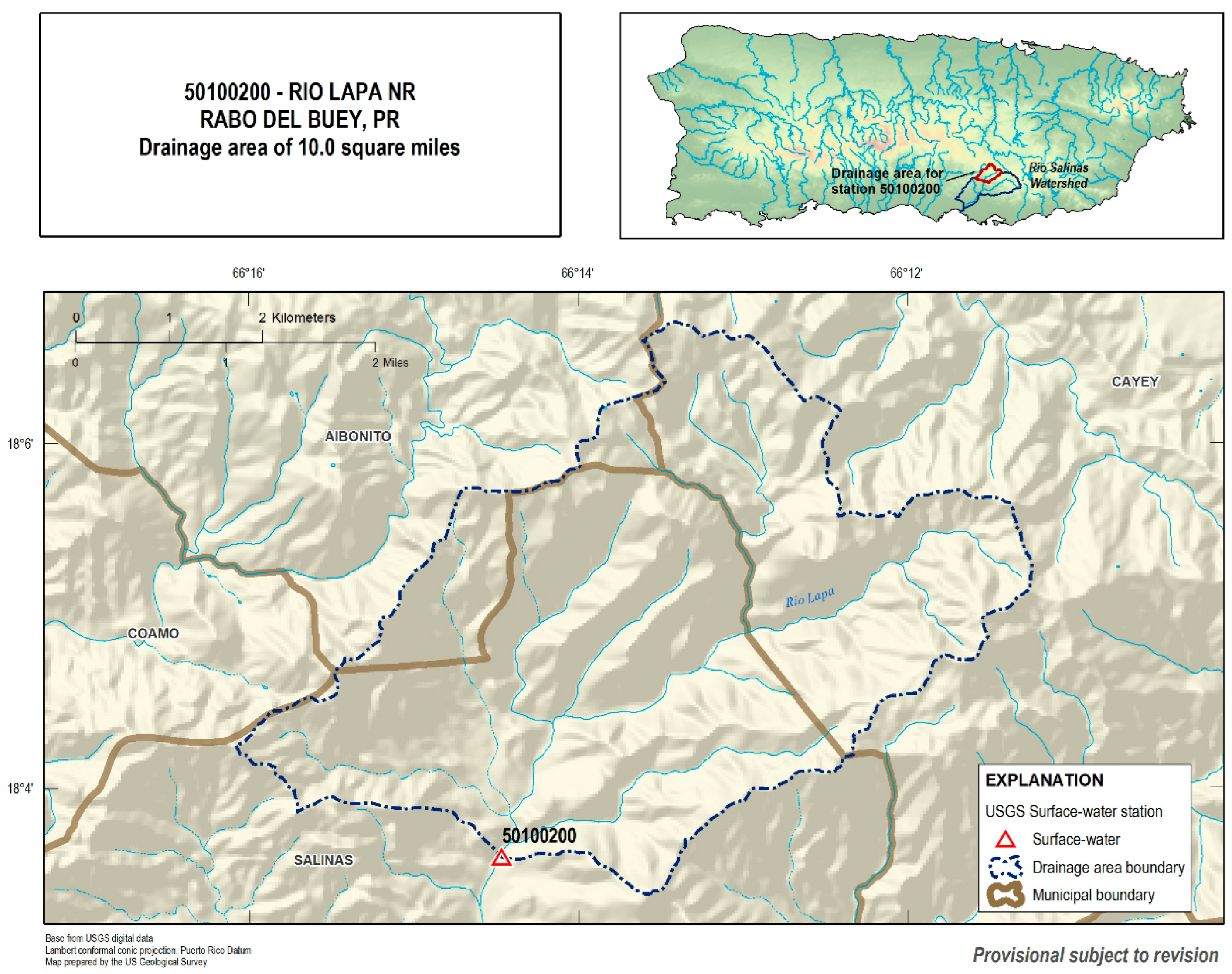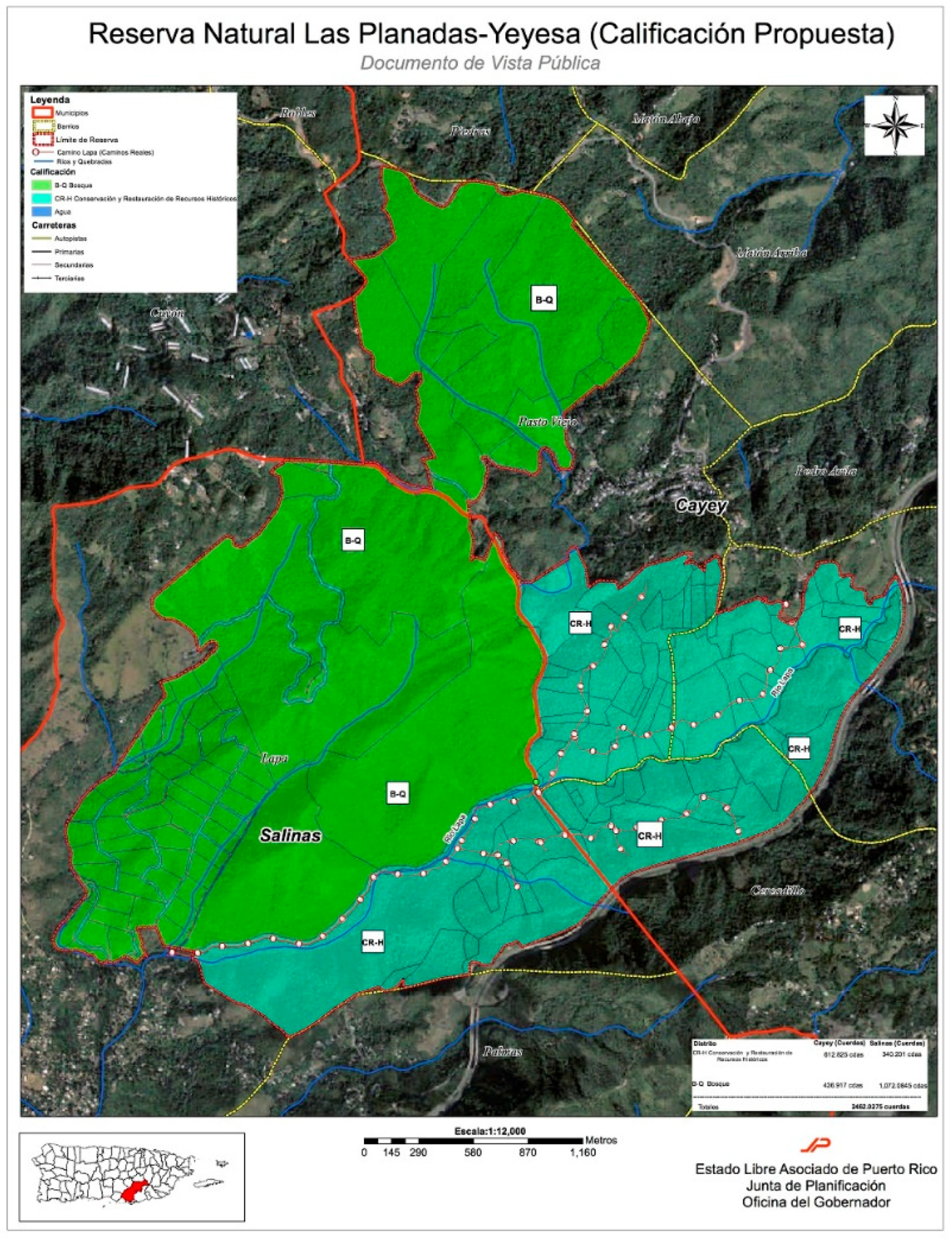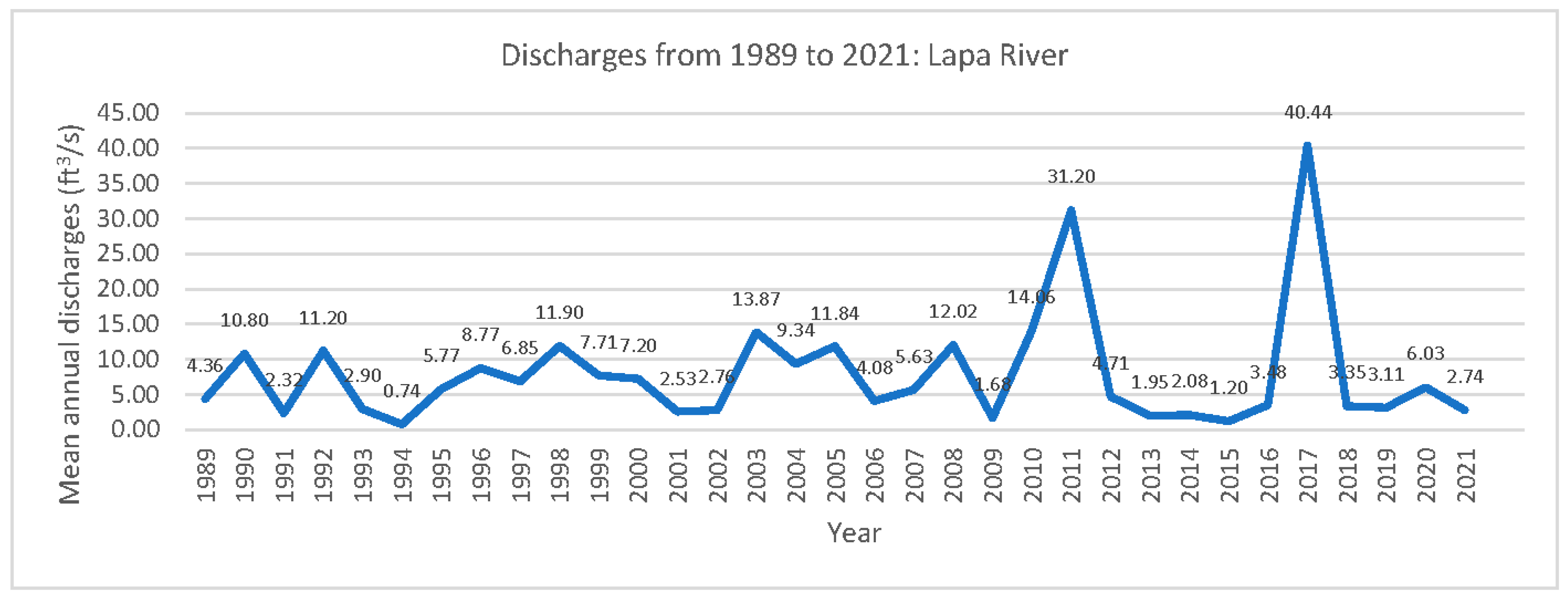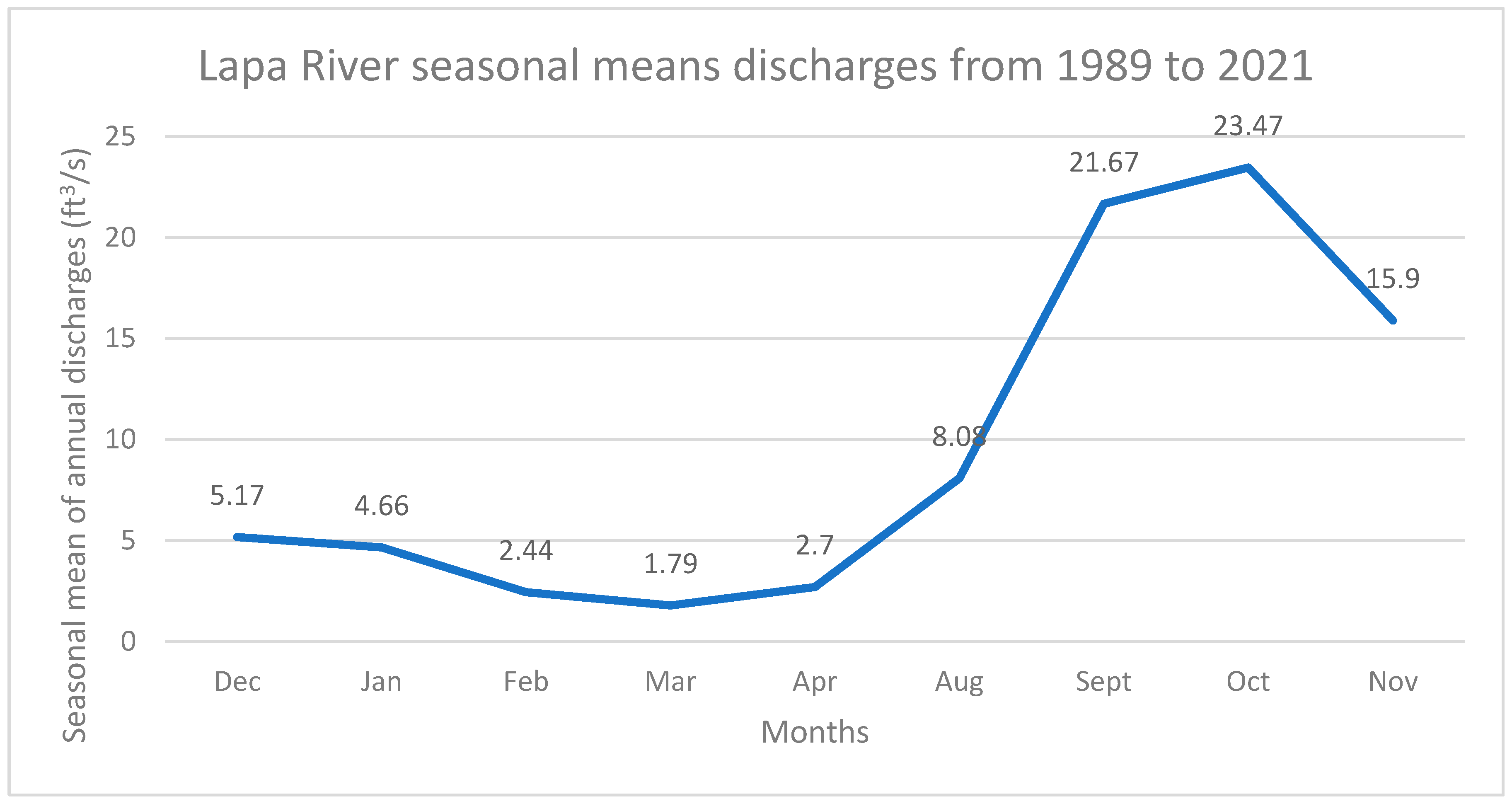Submitted:
07 October 2023
Posted:
10 October 2023
You are already at the latest version
Abstract
Keywords:
1. Introduction
2. River Discharges in Puerto Rico
3. Background and Problem
4. Methodology
5. Results
5.1. Temporal Variations in Water Discharges in the Lapa River
5.2. Seasonal Discharges
5.3. Description of the Impact of Atmospheric Events on the Water Discharges at the Lapa River
6. Conclusions
Funding
Institutional Review Board Statement
Informed Consent Statement
Data Availability Statement
Conflicts of Interest
Appendix A
| Year | Monthly Mean in ft3/s (Calculation Period: 1989-2021 | |||||||||||
|---|---|---|---|---|---|---|---|---|---|---|---|---|
| January | February | March | April | May | June | July | August | September | October | November | December | |
| 1989 | 1.14 | 1.60 | 0.74 | 0.32 | 0.30 | 0.46 | 0.14 | 0.18 | 29.10 | 13.10 | 3.98 | 1.27 |
| 1990 | 0.57 | 0.49 | 0.44 | 0.28 | 0.18 | 0.59 | 0.68 | 6.06 | 9.73 | 76.10 | 28.40 | 6.09 |
| 1991 | 3.74 | 12.40 | 1.75 | 0.99 | 1.50 | 0.83 | 0.60 | 0.60 | 0.82 | 1.46 | 2.17 | 0.96 |
| 1992 | 68.80 | 2.53 | 2.08 | 3.07 | 36.60 | 6.32 | 2.55 | 3.64 | 1.44 | 2.73 | 2.81 | 1.82 |
| 1993 | 1.36 | 0.99 | 0.80 | 1.39 | 1.71 | 10.40 | 7.80 | 3.94 | 2.46 | 2.02 | 1.07 | 0.89 |
| 1994 | 0.47 | 1.34 | 0.48 | 0.34 | 0.09 | 0.04 | 0.01 | 0.00 | 0.11 | 4.20 | 1.08 | 0.75 |
| 1995 | 0.48 | 3.22 | 0.93 | 1.23 | 1.42 | 1.70 | 1.75 | 1.82 | 36.60 | 13.80 | 3.14 | 3.16 |
| 1996 | 2.15 | 1.03 | 0.58 | 1.24 | 0.15 | 0.44 | 3.73 | 4.84 | 81.20 | 5.53 | 2.44 | 1.96 |
| 1997 | 0.98 | 1.17 | 0.71 | 0.44 | 0.17 | 0.07 | 0.04 | 0.20 | 0.05 | 55.50 | 20.00 | 2.86 |
| 1998 | 1.65 | 9.49 | 1.79 | 4.18 | 2.13 | 1.00 | 0.64 | 12.80 | 57.50 | 20.00 | 17.20 | 14.40 |
| 1999 | 8.28 | 4.00 | 2.59 | 1.98 | 2.51 | 1.70 | 1.06 | 2.41 | 11.30 | 9.15 | 36.40 | 11.10 |
| 2000 | 7.22 | 5.27 | 2.42 | 2.05 | 7.05 | 2.34 | 1.15 | 17.90 | 14.40 | 17.80 | 6.06 | 2.76 |
| 2001 | 1.44 | 0.97 | 1.08 | 1.18 | 4.90 | 0.68 | 0.16 | 7.70 | 1.36 | 1.26 | 5.33 | 4.34 |
| 2002 | 0.87 | 0.89 | 2.68 | 11.50 | 1.94 | 8.43 | 0.68 | 0.68 | 4.06 | 0.93 | 0.18 | 0.31 |
| 2003 | 0.32 | 0.23 | 0.27 | 20.70 | 1.06 | 0.38 | 1.14 | 3.81 | 5.20 | 12.20 | 88.10 | 33.00 |
| 2004 | 11.10 | 7.57 | 4.00 | 3.69 | 8.27 | 2.45 | 2.12 | 1.07 | 30.80 | 10.20 | 24.30 | 6.45 |
| 2005 | 5.12 | 2.16 | 1.33 | 1.22 | 4.51 | 2.01 | 12.20 | 3.67 | 3.21 | 77.30 | 22.00 | 7.31 |
| 2006 | 4.07 | 2.78 | 5.12 | 9.39 | 2.66 | 2.31 | 2.78 | 4.29 | 6.90 | 4.68 | 2.49 | 1.43 |
| 2007 | 1.04 | 0.98 | 0.98 | 0.93 | 0.61 | 0.34 | 0.19 | 0.75 | 0.20 | 37.00 | 10.10 | 14.50 |
| 2008 | 3.58 | 2.00 | 1.14 | 0.90 | 1.13 | 0.89 | 0.44 | 1.41 | 98.90 | 20.00 | 10.30 | 3.49 |
| 2009 | 2.40 | 1.53 | 2.62 | 0.79 | 1.41 | 0.88 | 1.22 | 0.49 | 1.03 | 1.21 | 0.67 | 5.91 |
| 2010 | 2.17 | 1.13 | 1.10 | 1.21 | 14.00 | 9.33 | 13.40 | 6.38 | 7.21 | 76.40 | 29.50 | 6.86 |
| 2011 | 3.50 | 1.92 | 1.41 | 2.62 | 34.90 | 30.50 | 26.40 | 133.30 | 96.80 | 26.10 | 13.10 | 3.85 |
| 2012 | 2.28 | 1.82 | 4.37 | 3.59 | 8.77 | 1.07 | 1.85 | 6.36 | 0.81 | 20.50 | 3.54 | 1.60 |
| 2013 | 1.07 | 0.93 | 2.05 | 1.40 | 1.78 | 0.60 | 1.78 | 0.79 | 7.96 | 1.10 | 1.97 | 2.01 |
| 2014 | 0.71 | 0.53 | 0.32 | 0.62 | 0.62 | 0.24 | 0.20 | 11.70 | 1.63 | 1.34 | 5.24 | 1.85 |
| 2015 | 1.23 | 1.39 | 0.53 | 0.44 | 0.34 | 0.22 | 0.09 | 0.46 | 0.12 | 5.81 | 2.80 | 0.97 |
| 2016 | 2.34 | 0.62 | 0.64 | 1.00 | 1.10 | 0.37 | 0.34 | 0.79 | 1.08 | 10.50 | 19.90 | 3.05 |
| 2017 | 0.63 | 0.70 | 6.54 | 3.41 | 8.87 | 0.95 | 1.45 | 3.68 | 164.40 | 182.60 | 98.70 | 13.40 |
| 2018 | 5.09 | 3.84 | 2.92 | 2.64 | 5.51 | 11.10 | 2.76 | 1.53 | 0.98 | 1.32 | 1.87 | 0.62 |
| 2019 | 0.92 | 0.67 | 0.62 | 0.49 | 0.43 | 0.24 | 0.28 | 5.11 | 5.48 | 13.40 | 6.79 | 2.89 |
| 2020 | 1.29 | 0.85 | 0.92 | 0.51 | 0.41 | 0.43 | 7.80 | 9.91 | 2.61 | 8.83 | 35.90 | 2.84 |
| 2021 | 1.23 | 0.93 | 1.28 | 0.62 | 0.45 | 0.62 | 0.35 | 0.33 | 8.13 | 17.00 | 1.24 | 0.69 |
References
- U.S. Geological Survey. Water Science School. Rivers, Streams, and Creeks. 2018. Available online: https://www.usgs.gov/special-topics/water-science-school/science/rivers-streams-and-creeks#overview (accessed on 10 October 2023).
- Morrone, J.J.; Escalante, T.; Rodriguez-Tapia, G.; Carmona, A.; Arana, M.; Mercado-Gómez, J.D. Biogeographic regionalization of the Neotropical region: New map and shapefile. An. Acad. Bras. Ciências 2022, 94, e20211167. [Google Scholar] [CrossRef] [PubMed]
- Albert, J.S.; Tagliacollo, V.A.; Dagosta, F. Diversification of Neotropical freshwater fishes. Annu. Rev. Ecol. Evol. Syst. 2020, 51, 27–53. [Google Scholar] [CrossRef]
- Pelicice, F.M.; Agostinho, A.A.; Azevedo-Santos, V.M.; Bessa, E.; Casatti, L.; Garrone-Neto, D.; Gomes, L.C.; Pavanelli, C.S.; Petry, A.C.; dos Santos Pompeu, P.; et al. Ecosystem services generated by Neotropical freshwater fishes. Hydrobiologia 2023, 850, 2903–2926. [Google Scholar] [CrossRef]
- Petsch, D.K.; Cionek, V.D.M.; Thomaz, S.M.; dos Santos, N.C.L. Ecosystem services provided by river-floodplain ecosystems. Hydrobiologia 2023, 850, 2563–2584. [Google Scholar] [CrossRef]
- Orozco-González, C.E.; Ocasio-Torres, M.E. Aquatic Macroinvertebrates as Bioindicators of Water Quality: A Study of an Ecosystem Regulation Service in a Tropical River. Ecologies 2023, 4, 209–228. [Google Scholar] [CrossRef]
- Hale, R.L.; Cook, E.M.; Beltrán, B.J. Cultural ecosystem services provided by rivers across diverse social-ecological landscapes: A social media analysis. Ecol. Indic. 2019, 107, 105580. [Google Scholar] [CrossRef]
- García-Alonso, J.; Lercari, D.; Defeo, O. Río de la Plata: A neotropical estuarine system. In Coasts and Estuaries; Elsevier: Amsterdam, The Netherlands, 2019; pp. 45–56. [Google Scholar]
- Caldeira, Y.M.; Casarim, R.; Pompeu, P.S. Natural variation of physical-habitat conditions among least-disturbed streams of a neotropical river basin in Brazil. Water Biol. Secur. 2023, 2, 100091. [Google Scholar] [CrossRef]
- Yu, X.; Zhang, W.; Hoitink, A.J.F. Impact of river discharge seasonality change on tidal duration asymmetry in the Yangtze River Estuary. Sci. Rep. 2020, 10, 6304. [Google Scholar] [CrossRef]
- Restrepo, J.D.; Escobar, R.; Tosic, M. Fluvial fluxes from the Magdalena River into Cartagena Bay, Caribbean Colombia: Trends, future scenarios, and connections with upstream human impacts. Geomorphology 2018, 302, 92–105. [Google Scholar] [CrossRef]
- Peluso, L.M.; Mateus, L.; Penha, J.; Bailly, D.; Cassemiro, F.; Suárez, Y.; Fantin-Cruz, I.; Kashiwaqui, E.; Lemes, P. Climate change negative effects on the Neotropical fishery resources may be exacerbated by hydroelectric dams. Sci. Total Environ. 2022, 828, 154485. [Google Scholar] [CrossRef]
- Erős, T.; Lowe, W.H. The landscape ecology of rivers: From patch-based to spatial network analyses. Curr. Landsc. Ecol. Rep. 2019, 4, 103–112. [Google Scholar] [CrossRef]
- Departamento de Recursos Naturales y Ambientales. Los Ríos. Hojas de Nuestro Ambiente. 2007. Available online: https://www.drna.pr.gov/wp-content/uploads/2015/04/Los-r%C3%ADos.pdf (accessed on 10 October 2023).
- Mejia Manrique, S.A.; Harmsen, E.W.; Khanbilvardi, R.M.; González, J.E. Flood impacts on critical infrastructure in a coastal floodplain in Western Puerto Rico during Hurricane María. Hydrology 2021, 8, 104. [Google Scholar] [CrossRef]
- Caldwell, P.V.; Kennen, J.G.; Hain, E.F.; Nelson, S.A.; Sun, G.; McNulty, S.G. Hydrologic Modeling for Flow-Ecology Science in the Southeastern United States and Puerto Rico; General Technical Report-Southern Research Station (SRS-246); USDA Forest Service: Missoula, MT, USA, 2020. [Google Scholar]
- Miller, P.W.; Kumar, A.; Mote, T.L.; Moraes, F.D.S.; Mishra, D.R. Persistent hydrological consequences of hurricane Maria in Puerto Rico. Geophys. Res. Lett. 2019, 46, 1413–1422. [Google Scholar] [CrossRef]
- Quiñones, F.; Torres, S. El Clima de Puerto Rico. Recursos de Agua de Puerto Rico. 2012. Available online: https://www.recursosaguapuertorico.com/Cartilla-del-Agua.html (accessed on 10 October 2023).
- Yu, M.; Gao, Q. Intra-and Inter-annual Variability in Freshwater Discharge of Tropical Mountainous Watersheds in the Caribbean under Changing Climate. In Proceedings of the AGU Fall Meeting Abstracts, Chicago, IL, USA, 12–16 December 2022; Volume 2022. id. B55H–1068. [Google Scholar]
- Rossi, M.W.; Whipple, K.X.; Vivoni, E.R. Precipitation and evapotranspiration controls on daily runoff variability in the contiguous United States and Puerto Rico. J. Geophys. Res. Earth Surf. 2016, 121, 128–145. [Google Scholar] [CrossRef]
- Acosta-Coll, M.; Ballester-Merelo, F.; Martinez-Peiró, M.; De la Hoz-Franco, E. Real-time early warning system design for pluvial flash floods—A review. Sensors 2018, 18, 2255. [Google Scholar] [CrossRef]
- Hall, J.; Scholl, M.; Gorokhovich, Y.; Uriarte, M. Forest cover lessens the impact of drought on streamflow in Puerto Rico. Hydrol. Process. 2022, 36, e14551. [Google Scholar] [CrossRef]
- Li, Y.; Wright, D.B.; Liu, Y. Flood-induced geomorphic change of floodplain extent and depth: A case study of hurricane maria in Puerto Rico. J. Hydrol. Eng. 2022, 27, 04022019. [Google Scholar] [CrossRef]
- Ríos-Touma, B.; Ramírez, A. Multiple stressors in the Neotropical region: Environmental impacts in biodiversity hotspots. In Multiple Stressors in River Ecosystems; Elsevier: Amsterdam, The Netherlands, 2019; pp. 205–220. [Google Scholar]
- Sánchez-Colón, Y.M.; Schaffner, F.C. Identifying nonpoint sources of phosphorus and nitrogen: A case study of pollution that enters a freshwater wetland (Laguna Cartagena, Puerto Rico). J. Water Resour. Prot. 2021, 13, 588–604. [Google Scholar] [CrossRef]
- Gutiérrez, P.E.; Ramírez, A. Evaluación de la calidad ecológica de los ríos en Puerto Rico: Principales amenazas y herramientas de evaluación. Hidrobiológica 2016, 26, 433–441. [Google Scholar]
- Zimmerman, J.K.; Willig, M.R.; Hernández-Delgado, E.A. Resistance, resilience, and vulnerability of social-ecological systems to hurricanes in Puerto Rico. Ecosphere 2020, 11, e03159. [Google Scholar] [CrossRef]
- Collazo, J.A.; Terando, A.J.; Engman, A.C.; Fackler, P.F.; Kwak, T.J. Toward a resilience-based conservation strategy for wetlands in Puerto Rico: Meeting challenges posed by environmental change. Wetlands 2019, 39, 1255–1269. [Google Scholar] [CrossRef]
- Departamento de Recursos Naturales y Ambientales. Programa Ríos Patrimoniales de Puerto Rico. Designación Tipo 2: Tramos de los Ríos que Nacen en los Bosques Protegidos por el DNER u Otras Areas Protegidas [Internet]. 2016. Available online: http://DNER.pr.gov/wp-content/uploads/formidable/Designaci%C3%B3n-Ríos-Patrimoniales.pdf (accessed on 10 October 2023).
- U.S. Geological Survey. Available online: https://waterdata.usgs.gov/monitoring-location/50100200/ (accessed on 10 October 2023).
- NOAA National Centers for Environmental Information. Monthly Tropical Cyclones Report for September 2017, Published Online October 2017. Available online: https://www.ncei.noaa.gov/access/monitoring/monthly-report/tropical-cyclones/201709 (accessed on 3 October 2023).
- Byrne, M.J., Sr. Monitoring Storm Tide, Flooding, and Precipitation from Hurricane Maria in Puerto Rico and the US Virgin Islands, September 2017 (No. 2019-1065); US Geological Survey: Reston, VA, USA, 2019. [Google Scholar]
- Keellings, D.; Hernández Ayala, J.J. Extreme rainfall associated with Hurricane Maria over Puerto Rico and its connections to climate variability and change. Geophys. Res. Lett. 2019, 46, 2964–2973. [Google Scholar] [CrossRef]
- Vélez, A.; Martin-Vide, J.; Royé, D.; Santaella, O. Spatial analysis of daily precipitation concentration in Puerto Rico. Theor. Appl. Climatol. 2019, 136, 1347–1355. [Google Scholar] [CrossRef]




| Mean | 7.84 |
| Standard Error | 1.44 |
| Median | 5.63 |
| Standard Deviation | 8.30 |
| Sample Variance | 68.85 |
| Kurtosis | 8.20 |
| Skewness | 2.66 |
| Range | 39.70 |
| Minimum | 0.74 |
| Maximum | 40.44 |
| Mean | 6.03 |
| Standard Error | 0.73 |
| Median | 4.71 |
| Standard Deviation | 4.05 |
| Sample Variance | 16.44 |
| Kurtosis | −0.91 |
| Skewness | 0.63 |
| Range | 13.32 |
| Minimum | 0.74 |
| Maximum | 14.06 |
| Year | Monthly Mean in ft3/s (Calculation Period: 1989-2021 | |||||||||||
|---|---|---|---|---|---|---|---|---|---|---|---|---|
| January | February | March | April | May | June | July | August | September | October | November | December | |
| 1989 | 1.14 | 1.60 | 0.74 | 0.32 | 0.30 | 0.46 | 0.14 | 0.18 | *29.10 | 13.10 | 3.98 | 1.27 |
| 1990 | 0.57 | 0.49 | 0.44 | 0.28 | 0.18 | 0.59 | 0.68 | 6.06 | 9.73 | *76.10 | 28.40 | 6.09 |
| 1991 | 3.74 | 12.40 | 1.75 | 0.99 | 1.50 | 0.83 | 0.60 | 0.60 | 0.82 | 1.46 | 2.17 | 0.96 |
| 1992 | *68.80 | 2.53 | 2.08 | 3.07 | *36.60 | 6.32 | 2.55 | 3.64 | 1.44 | 2.73 | 2.81 | 1.82 |
| 1993 | 1.36 | 0.99 | 0.80 | 1.39 | 1.71 | 10.40 | 7.80 | 3.94 | 2.46 | 2.02 | 1.07 | 0.89 |
| 1994 | 0.47 | 1.34 | 0.48 | 0.34 | 0.09 | 0.04 | 0.01 | 0.00 | 0.11 | 4.20 | 1.08 | 0.75 |
| 1995 | 0.48 | 3.22 | 0.93 | 1.23 | 1.42 | 1.70 | 1.75 | 1.82 | *36.60 | *13.80 | 3.14 | 3.16 |
| 1996 | 2.15 | 1.03 | 0.58 | 1.24 | 0.15 | 0.44 | 3.73 | 4.84 | *81.20 | 5.53 | 2.44 | 1.96 |
| 1997 | 0.98 | 1.17 | 0.71 | 0.44 | 0.17 | 0.07 | 0.04 | 0.20 | 0.05 | *55.50 | 20.00 | 2.86 |
| 1998 | 1.65 | 9.49 | 1.79 | 4.18 | 2.13 | 1.00 | 0.64 | 12.80 | *57.50 | 20.00 | 17.20 | 14.40 |
| 1999 | 8.28 | 4.00 | 2.59 | 1.98 | 2.51 | 1.70 | 1.06 | 2.41 | 11.30 | 9.15 | *36.40 | 11.10 |
| 2000 | 7.22 | 5.27 | 2.42 | 2.05 | 7.05 | 2.34 | 1.15 | *17.90 | *14.40 | *17.80 | 6.06 | 2.76 |
| 2001 | 1.44 | 0.97 | 1.08 | 1.18 | 4.90 | 0.68 | 0.16 | 7.70 | 1.36 | 1.26 | 5.33 | 4.34 |
| 2002 | 0.87 | 0.89 | 2.68 | 11.50 | 1.94 | 8.43 | 0.68 | 0.68 | 4.06 | 0.93 | 0.18 | 0.31 |
| 2003 | 0.32 | 0.23 | 0.27 | 20.70 | 1.06 | 0.38 | 1.14 | 3.81 | 5.20 | 12.20 | *88.10 | 33.00 |
| 2004 | 11.10 | 7.57 | 4.00 | 3.69 | 8.27 | 2.45 | 2.12 | 1.07 | *30.80 | 10.20 | 24.30 | 6.45 |
| 2005 | 5.12 | 2.16 | 1.33 | 1.22 | 4.51 | 2.01 | 12.20 | 3.67 | 3.21 | *77.30 | 22.00 | 7.31 |
| 2006 | 4.07 | 2.78 | 5.12 | 9.39 | 2.66 | 2.31 | 2.78 | 4.29 | 6.90 | 4.68 | 2.49 | 1.43 |
| 2007 | 1.04 | 0.98 | 0.98 | 0.93 | 0.61 | 0.34 | 0.19 | 0.75 | 0.20 | *37.00 | 10.10 | 14.50 |
| 2008 | 3.58 | 2.00 | 1.14 | 0.90 | 1.13 | 0.89 | 0.44 | 1.41 | *98.90 | *20.00 | 10.30 | 3.49 |
| 2009 | 2.40 | 1.53 | 2.62 | 0.79 | 1.41 | 0.88 | 1.22 | 0.49 | 1.03 | 1.21 | 0.67 | 5.91 |
| 2010 | 2.17 | 1.13 | 1.10 | 1.21 | 14.00 | 9.33 | 13.40 | 6.38 | 7.21 | *76.40 | *29.50 | 6.86 |
| 2011 | 3.50 | 1.92 | 1.41 | 2.62 | *34.90 | *30.50 | *26.40 | *133.30 | *96.80 | *26.10 | 13.10 | 3.85 |
| 2012 | 2.28 | 1.82 | 4.37 | 3.59 | 8.77 | 1.07 | 1.85 | 6.36 | 0.81 | *20.50 | 3.54 | 1.60 |
| 2013 | 1.07 | 0.93 | 2.05 | 1.40 | 1.78 | 0.60 | 1.78 | 0.79 | 7.96 | 1.10 | 1.97 | 2.01 |
| 2014 | 0.71 | 0.53 | 0.32 | 0.62 | 0.62 | 0.24 | 0.20 | 11.70 | 1.63 | 1.34 | 5.24 | 1.85 |
| 2015 | 1.23 | 1.39 | 0.53 | 0.44 | 0.34 | 0.22 | 0.09 | 0.46 | 0.12 | 5.81 | 2.80 | 0.97 |
| 2016 | 2.34 | 0.62 | 0.64 | 1.00 | 1.10 | 0.37 | 0.34 | 0.79 | 1.08 | 10.50 | *19.90 | 3.05 |
| 2017 | 0.63 | 0.70 | 6.54 | 3.41 | 8.87 | 0.95 | 1.45 | 3.68 | *164.40 | *182.60 | *98.70 | 13.40 |
| 2018 | 5.09 | 3.84 | 2.92 | 2.64 | 5.51 | 11.10 | 2.76 | 1.53 | 0.98 | 1.32 | 1.87 | 0.62 |
| 2019 | 0.92 | 0.67 | 0.62 | 0.49 | 0.43 | 0.24 | 0.28 | 5.11 | 5.48 | 13.40 | 6.79 | 2.89 |
| 2020 | 1.29 | 0.85 | 0.92 | 0.51 | 0.41 | 0.43 | 7.80 | 9.91 | 2.61 | 8.83 | *35.90 | 2.84 |
| 2021 | 1.23 | 0.93 | 1.28 | 0.62 | 0.45 | 0.62 | 0.35 | 0.33 | 8.13 | 17.00 | 1.24 | 0.69 |
Disclaimer/Publisher’s Note: The statements, opinions and data contained in all publications are solely those of the individual author(s) and contributor(s) and not of MDPI and/or the editor(s). MDPI and/or the editor(s) disclaim responsibility for any injury to people or property resulting from any ideas, methods, instructions or products referred to in the content. |
© 2023 by the authors. Licensee MDPI, Basel, Switzerland. This article is an open access article distributed under the terms and conditions of the Creative Commons Attribution (CC BY) license (http://creativecommons.org/licenses/by/4.0/).





